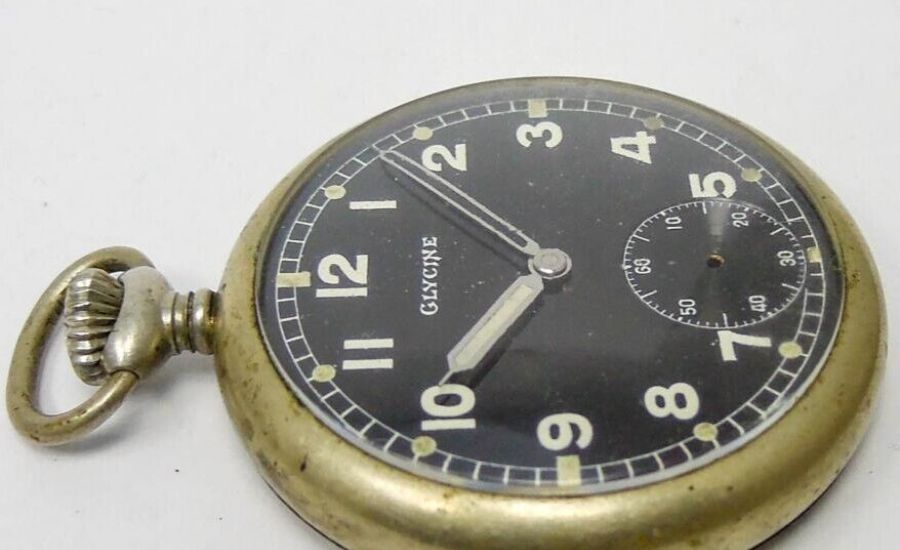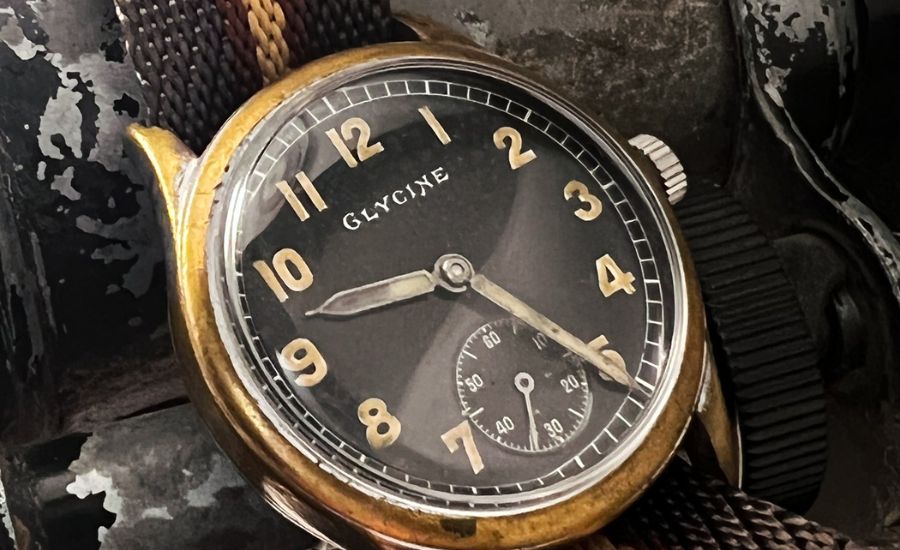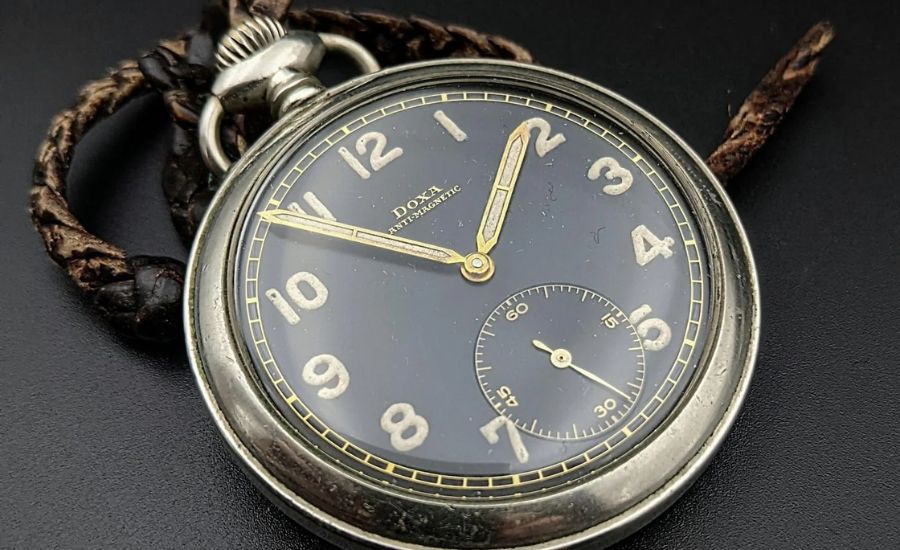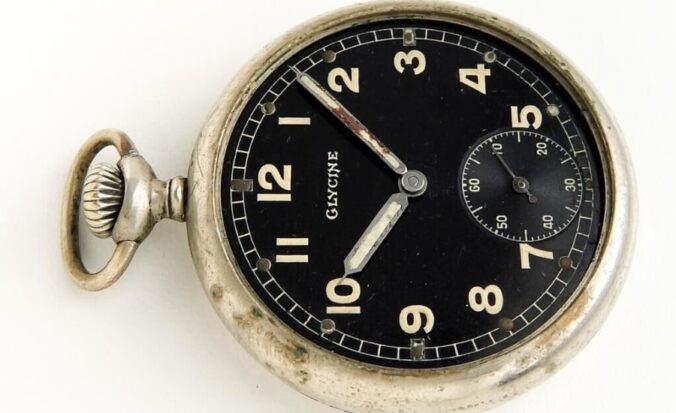Introduction to Glycine F283 Military Pocket Watch Ww2 Period 1940s
The Glycine F283 Military Pocket Watch from the 1940s is a quintessential timepiece that holds significant historical value, particularly for those with an interest in World War II artifacts and military watches. Glycine, a Swiss watch manufacturer, has long been known for producing durable and reliable watches, and the F283 model is no exception. This article will delve into the history, features, and legacy of the Glycine F283 military pocket watch, exploring its role during WWII and its continued relevance to collectors and horology enthusiasts today.
The Glycine F283 Military Pocket Watch is a product of an era defined by wartime necessities, technological advancement, and military precision. During World War II, timekeeping was critical for soldiers and officers, and the Glycine F283 was designed with the military in mind. As warfare evolved, so did the need for watches that were not only functional but also durable and easy to use in demanding environments. The Glycine F283 met these criteria and quickly became a trusted companion for soldiers, providing them with a reliable timepiece that could withstand the rigors of combat.
Features and Design of the Glycine F283 Military Pocket Watch

The Glycine F283 military pocket watch was built to endure the demanding conditions of warfare. It was crafted from durable materials designed to withstand shock, moisture, and extreme temperatures. The case was made of stainless steel, which provided the necessary protection for the movement inside, ensuring the watch continued to function even under the harshest conditions. This robust construction made the Glycine F283 an ideal choice for military personnel who needed a watch that could withstand the rigors of combat and outdoor environments.
The Movement: Precision Timekeeping
The F283 was powered by a mechanical movement, specifically the hand-wound Caliber 283, which was renowned for its accuracy and reliability. At a time when quartz technology had not yet revolutionized watchmaking, mechanical movements were the standard for military and aviation watches. The Caliber 283 was known for its precision, allowing military personnel to rely on the timepiece for coordinating operations and keeping track of mission timings.
Readable Dial and Luminescence
One of the standout features of the Glycine F283 military pocket watch was its clear and easily readable dial. The face of the watch was designed for maximum legibility, with bold Arabic numerals and large, luminous hands. These features were essential for soldiers who needed to quickly check the time in low-light conditions, such as in trenches or during nighttime operations. The luminous paint on the dial allowed for visibility even in the darkest environments, ensuring that the watch could be read at all times.
Size and Weight
The Glycine F283 was relatively compact for a military pocket watch, with a diameter of approximately 50mm. Its large size made it easy to read, but the watch was still light enough to be carried comfortably in a pocket. The weight of the watch was balanced, offering a sturdy feel without being overly cumbersome. The pocket watch design also allowed for easy attachment to a chain, making it practical for soldiers who needed quick access to the timepiece while on the move.
The Role of the Glycine F283 in WWII
During World War II, accurate timekeeping was essential for soldiers and officers alike. The Glycine F283 military pocket watch served a critical role in helping military personnel coordinate operations, whether on the battlefield, during air raids, or in covert missions. The pocket watch became an invaluable tool for soldiers, who relied on it for everything from timing bombings to coordinating troop movements.
Glycine’s F283 was used extensively by military forces, particularly in the European theater, where precision and timing were essential to the success of military campaigns. The military demanded watches that could not only survive the harsh conditions of war but also provide accurate timekeeping for a variety of tasks. The F283 was one of the watches that soldiers could trust, making it a vital piece of equipment in wartime.
Glycine F283 in the Post-WWII Era
After World War II, the Glycine F283 continued to be a beloved piece of history for collectors and watch enthusiasts. Its association with the wartime era, combined with its exceptional design and functionality, ensured its place as a sought-after collector’s item. As the demand for pocket watches diminished with the advent of wristwatches in the postwar era, the Glycine F283 remained a symbol of the enduring legacy of military timepieces.
Even as wristwatches became more popular in the 1950s and beyond, the F283 continued to hold sentimental and historical value. Many surviving examples of the Glycine F283 military pocket watch are now considered rare antiques, sought after by collectors who appreciate the craftsmanship and history behind these timepieces.
The Collectibility of the Glycine F283 Military Pocket Watch

Today, the Glycine F283 military pocket watch is a highly collectible item. Its historical significance, coupled with its durability and design, makes it a desirable watch for collectors of military and vintage timepieces. The F283’s limited availability, especially in good condition, has only increased its appeal. Authentic Glycine F283 watches, particularly those from the 1940s, are considered rare and valuable.
Collectors value the F283 not just for its functionality but also for its connection to a significant period in history. As a symbol of WWII-era military technology and precision, the Glycine F283 is more than just a watch—it is a piece of history that allows modern enthusiasts to connect with the past.
Glycine F283 in Modern Times: Restorations and Reproductions
In recent years, Glycine has continued to honor its legacy by producing modern versions of the F283 and other vintage military models. These contemporary versions are often built with updated materials and movements but retain the design and spirit of their predecessors. For collectors, these modern iterations provide a way to experience the look and feel of the original Glycine F283 while benefiting from the advancements in watch technology.
Furthermore, there has been a resurgence of interest in vintage military watches, with many collectors seeking to restore or preserve original pieces like the F283. Restoration specialists and watchmakers who specialize in vintage military watches can help bring the Glycine F283 back to its original condition, allowing collectors to enjoy these timepieces in their full glory.
Glycine’s Legacy in Watchmaking

Glycine, founded in 1914 in Bienne, Switzerland, is a company with a long tradition of watchmaking. Known for its innovative designs and commitment to precision, Glycine became synonymous with the production of military and aviation watches in the 20th century. The company’s watches were used by various armed forces worldwide, and their products were highly regarded for their robustness, legibility, and functionality. The F283, in particular, became one of Glycine’s iconic military timepieces, especially during World War II.
The Glycine F283 military pocket watch was designed during a time when the demand for rugged, accurate timepieces was at its peak. Military personnel needed watches that could withstand harsh conditions while providing accurate timekeeping for mission-critical operations. Glycine met these demands, and the F283 became a symbol of precision and reliability during the war.
Conclusion
The Glycine F283 military pocket watch is a remarkable timepiece that embodies the precision, durability, and reliability required of military watches during World War II. Its historical significance, coupled with its timeless design and functionality, makes it a highly sought-after collectible. For enthusiasts and collectors of military watches, the Glycine F283 offers a unique glimpse into the past, reminding us of the vital role that timepieces played in shaping the course of history. Whether as a functional tool or as a cherished relic of the past, the Glycine F283 continues to stand as a testament to the enduring legacy of military craftsmanship and Swiss watchmaking excellence.
FAQs about the Glycine F283 Military Pocket Watch
1. What is the Glycine F283 Military Pocket Watch?
The Glycine F283 is a military pocket watch produced in the 1940s, specifically during World War II. Known for its robust design and accurate timekeeping, this timepiece was used by military personnel for various tasks, from coordinating troop movements to timing bombing raids. The F283 is a classic example of precision and durability in military watches.
2. What makes the Glycine F283 different from other military watches?
The Glycine F283 stands out for its excellent build quality, with a durable stainless steel case and a clear, highly readable dial. Its large size, luminous hands, and Arabic numerals made it easy to read in low-light conditions, which was essential for soldiers. Additionally, its mechanical movement, Caliber 283, provided exceptional accuracy, making it highly trusted by military personnel during the 1940s.
3. Why is the Glycine F283 a collector’s item?
The Glycine F283 is highly sought after by collectors due to its historical significance, rarity, and craftsmanship. As a watch produced during WWII, it offers a tangible connection to a critical period in history. Its limited availability, especially models in good condition, and its place in the history of military timepieces have made it a valuable collector’s item.
4. How do I know if my Glycine F283 is authentic?
Authenticating a Glycine F283 involves looking for specific details such as the brand’s logo, serial numbers, and markings on the case and movement. Reputable dealers and watchmakers can assist in verifying authenticity, especially for vintage timepieces. Additionally, knowledge of the F283’s design features, like its luminous hands and dial, can help determine if the watch is original.
5. Can I still find working Glycine F283 watches today?
Yes, working Glycine F283 watches can still be found, though they are rare and often require restoration. Many collectors seek out these vintage pieces for their historical value and craftsmanship. It’s also possible to find modern reissues of the F283 that retain the design and spirit of the original model while using updated technology.
6. What is the value of a Glycine F283 military pocket watch?
The value of a Glycine F283 military pocket watch depends on factors like its condition, rarity, and provenance. A well-preserved example in good working order can command significant prices in the collector’s market, particularly those with original features. Restored models may be priced lower, but still hold value due to their historical significance.
7. What was the role of the Glycine F283 during WWII?
The Glycine F283 served as a practical and reliable timepiece for military personnel during WWII. Its durability and accurate timekeeping made it an essential tool for soldiers and officers in various military operations, from coordinating troop movements to timing missions and air raids. The watch helped soldiers maintain precision, even in the harshest environments.
Key Facts about the Glycine F283 Military Pocket Watch
- Historical Significance: The Glycine F283 was produced during World War II and was widely used by military personnel, especially during the 1940s. It served as a reliable and essential tool for soldiers, offering precise timekeeping in critical missions.
- Durable Build: The watch was constructed from stainless steel, ensuring it could withstand rough conditions, such as extreme temperatures, moisture, and shocks. Its robust design made it ideal for military environments where timepieces needed to endure physical stress.
- Precise Movement: The F283 was powered by the mechanical Caliber 283 movement, known for its accuracy. Mechanical watches like the F283 were the standard during WWII, and they provided the reliability required by military personnel for coordinating operations.
- Readable Dial: One of the standout features of the Glycine F283 was its highly legible dial, which included large Arabic numerals and luminous hands. This feature made it easier for soldiers to read the time, even in low-light conditions, such as during nighttime operations.
- A Symbol of Military Precision: The Glycine F283 became a symbol of military precision and reliability. It represented the highest standards of Swiss craftsmanship, offering the accuracy and durability that soldiers needed during WWII.
- Sought-After Collectible: Today, the Glycine F283 is a highly coveted collector’s item. Its rarity, historical importance, and excellent craftsmanship make it a valuable piece for watch collectors and history enthusiasts alike.
- Modern Reissues: In recent years, Glycine has produced reissues of the F283, which closely replicate the design and feel of the original model. These modern versions offer an opportunity for enthusiasts to own a timepiece inspired by a classic military watch.
- Restoration and Preservation: Many surviving F283 pocket watches have undergone restoration to bring them back to their original condition. Specialist watchmakers are skilled in restoring vintage timepieces, ensuring these watches continue to work and maintain their value.
- Collecting Military Watches: Collecting vintage military watches like the Glycine F283 has become increasingly popular among horology enthusiasts. These watches offer a tangible connection to significant historical events, such as WWII, and represent the craftsmanship and reliability demanded by military forces.
- Legacy of Swiss Watchmaking: Glycine’s legacy as a manufacturer of high-quality military watches is cemented through timepieces like the F283. The brand is renowned for producing watches that not only look great but are also built to perform in demanding situations.
Read more Information about Lifestyle at Visit SearchKnowledge

Leave a Reply